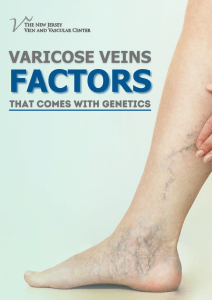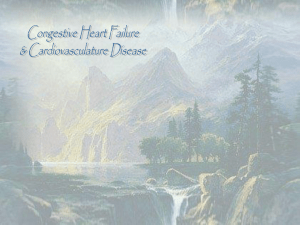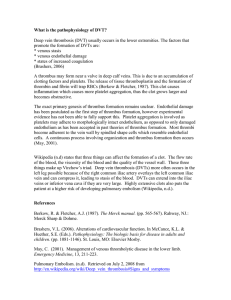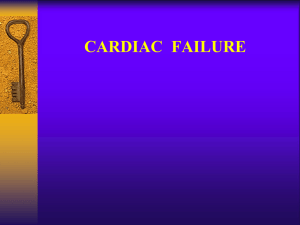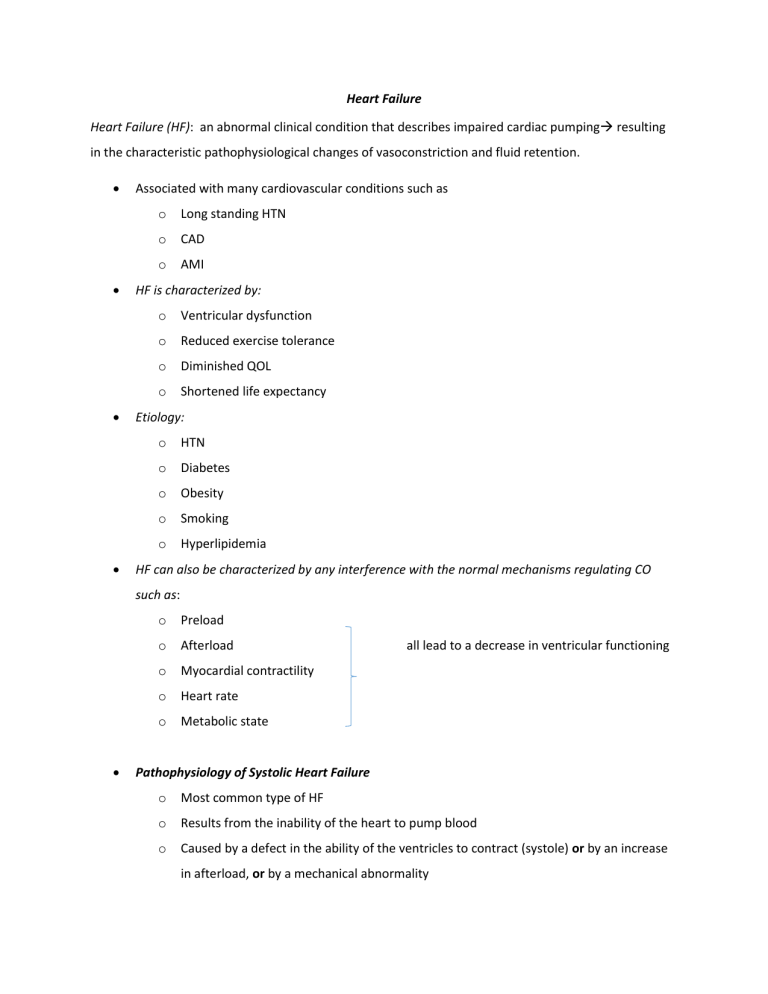
Heart Failure Heart Failure (HF): an abnormal clinical condition that describes impaired cardiac pumping resulting in the characteristic pathophysiological changes of vasoconstriction and fluid retention. Associated with many cardiovascular conditions such as o Long standing HTN o CAD o AMI HF is characterized by: o Ventricular dysfunction o Reduced exercise tolerance o Diminished QOL o Shortened life expectancy Etiology: o HTN o Diabetes o Obesity o Smoking o Hyperlipidemia HF can also be characterized by any interference with the normal mechanisms regulating CO such as: o Preload o Afterload o Myocardial contractility o Heart rate o Metabolic state all lead to a decrease in ventricular functioning Pathophysiology of Systolic Heart Failure o Most common type of HF o Results from the inability of the heart to pump blood o Caused by a defect in the ability of the ventricles to contract (systole) or by an increase in afterload, or by a mechanical abnormality What happens: o The LV loses its ability to generate enough pressure to eject blood forward through the high pressured aorta. o The hallmark of systolic HF is a decrease in the LV ejection fraction (EF) (% of the total amount of blood in the LV ejected during each ventricular contraction) o Normal EF is 55% of the total ventricular volume o What happens is that when the EF decreases there is left over blood volume sitting in the LV which eventually fills up the left ventricle and continues to back up (remember the normal circulation of the heart so you know where the blood will back up into). Systolic HF is caused then by: o Impaired contractility o Increase in afterload (increase resistance) o Cardiomyopathies o Mechanical abnormalities Pathophysiology of Diastolic Failure (DF) o Often referred to as HF with preserved systolic function o It is an impaired ability of the ventricles to fill during diastole o Decreased filling of the ventricles will lead to a decrease SV Diastolic Failure is characterized by o High filling pressures which results in venous engorgement in both the pulmonary and systemic vascular systems o Is usually a result of left ventricular hypertrophy from chronic HTN or aortic stenosis. Diagnosis of diastolic failure is made by o Evidence of pulmonary congestion o Pulmonary hypertension o Ventricular hypertrophy o Normal EF Mixed Systolic & Diastolic Failure o Have poor EF (<35) o High pulmonary pressures o Bi-ventricular failure The client will have o Low BP o Decreased CO o Poor renal perfusion o Poor exercise intolerance Compensatory Mechanisms o HF can have an abrupt onset s with a AMI or can be an insidious onset o The overload of the heart resorts to certain compensatory mechanisms to try to maintain effective CO The main compensatory mechanisms are: 1. Ventricular dilation 2. Ventricular hypertrophy 3. Increase in SNS stimulation 4. Neurohormonal responses (RAAS and endothelin & natriuretic peptides) Ventricular Dilation o Enlargement of the chambers of the heart occurs when the pressures in the heart chambers (usually LV) is increased overtime ↓ o The muscle fibres of the heart stretch in response to the volume of blood in the heart at the end of diastole ↓ o The degree of stretch is directly related to the force of the contraction (Starling’s Law) ↓ o In the beginning dilation is an adaptive mechanism to cope with the increased blood volume and increase in contraction leads to an increase in CO & maintenance of the arterial BP and perfusion by the heart o Overtime however the elastic elements of the muscle fibers are over stretched and can no longer contract effectively or efficiently so the CO diminishes Ventricular Hypertrophy o Is an increase in the muscle mass & cardiac wall thickness in response to the overworked & strain of chronic HF o o This increase in muscle mass & cardiac wall thickening happens slowly because it takes time for this muscle tissue to develop o Hypertrophy usually follows the compensatory mechanism of ventricle dilation which further increases the contractile power of the muscle fibres ↓ o This will lead to an increase CO & maintenance of tissue perfusion o The hypertrophic heart muscle however has poor contractility, and requires more 02 to perform; has poor coronary artery circulation & is prone to ventricular dysrhythmias SNS Activation Often the first mechanism triggered in low CO, but it is the least effective compensatory mechanism When there is a decrease in SV/CO……there is an increase in epinephrine & nor-epinephrine ↓ This increases HR, myocardial contractility & peripheral vascular resistance (constriction) ↓ In the beginning contractility & CO are improved with the increased HR but overtime ↓ These factors are counter-productive instead increasing the myocardium need for 02 and the workload of an already failing heart ↓ Vasoconstriction causes an immediate increase in preload which may increase CO initially but an increase in the venous return to the heart where there is already volume overload worsens ventricular performance Neurohormonal Response A. As CO decreases--- decreased perfusion to the kidneys ↓ Juxtaglomerular apparatus in the kidney senses the low blood volume and stimulates the kidney to release renin which converts AT 1 to AT 2 by ACE ↓ AT 2 does two things: (a) causes peripheral vasoconstriction in order to increase BP (b) overtime causes aldosterone to be released from the adrenal cortex which will increase Na & H2O retention B. Endothelin produced by the vascular endothelial cells is stimulated by ADH, catecholamines & AT2 ↓ Endothelin resultsn further arterial vasoconstriction & increases cardiac contractility & ventricular hypertrophy The body’s ability to try to maintain balance is demonstrated by counter-regulatory process such as atrial natriuretic peptide & brain natriuretic peptide which are both hormones produced by the heart muscle that promote venous and atrial vasodilation (which will decrease afterload & preload) Types of Heart Failure Left Sided: trace the blood backward from the LV to find out where the blood volume will accumulate…..this will then allow you to think of the manifestations the patient can experience Right Sided: continue to trace the blood backward from where left sided heart failure lead you as most commonly the cause of RF is LF. Think of the manifestations that will result because of this. Left Sided Failure from an Increase in SVR (Lewis, et.al., 2013. p. 932) Clinical Manifestations of Acute Decompensated HF (ADHF) Regardless of cause ADHF typically manifests as pulmonary edema Lung alveoli fill with serous or serosanguinous fluid In most cases of ADHF there is an increase in pulmonary venous pressure caused by decreased efficiency in the LV Results in engorgement of the pulmonary vascular system Lungs become less compliant Which increase resistance in small airways If pulmonary pressures continue to increase there will be an increase in intravascular pressure which will cause the fluid to move into the interstitial space which will be to much for the lymphatics can drain. This will cause interstitial edema which will increase RR &SOBOE & at rest If pulmonary venous pressures continue to increase the cells of the alveoli’s lining become disrupted & fluid containing RBCs moves into the alveoli- which translates to fluid with fluid (in the alveoli & airways) which will worsen breathing and gas exchange Diagnostic Tests for HF 1. History & PE 2. ABG’S, electrolytes, LFTs, BNP, cardiac enzymes 3. CXR 4. ECG 5. Echo, stress test, cardiac catheterization Collaborative Care When we look how to treat patients with chronic CHF we first have to have a plan: 1. Identify the type of CHF they have & the causes 2. Correct sodium & water retention 3. Reduce the amount of work by the heart 4. Improve myocardial contractility 5. Control for factors that could precipitate an acute episode & those that could complicate the CHF 6. Improve symptoms, minimize side effects 7. Prevent morbidity & prolong life Pharmacological Considerations: 1. ACE inhibitors (drugs ending in “pril”) Used to treat systolic & diastolic heart failure First line treatment for acute episodes of CHF The drug works by preventing angiotensin 1 from converting to angiotensin 2 (which is potent vasoconstrictor & sets up the release of aldosterone from adrenal cortex) an ACE will block this ACE inhibitors also decrease: o SVR allowing for greater CO o Pulmonary artery pressures o Right atrial pressures o LV filling pressures Beta Blockers o Can be started on patients who cannot take ACE inhibitors or in combination with other drugs such as digoxin, diuretics o Only 3 beta blockers are considered for treating pt’s with CHF (carvedilol and long acting metoprolol & bisoprolol) o “They directly block the SNS’s negative effects on the failing heart such as increased heart rate” o B-blockers must be started gradually and dose increased slowly every 2 weeks & proceed slowly (and tolerated by pt) Diuretic Therapy Indicated for patients with fluid retention They interfere with heart failure-induced sodium retention; inhibiting sodium or chloride reabsorption in the renal tubules & excrete water (↓ amount of blood returning to the heart) Loop diuretics (Lasix) affect the loop of Henle are the best diuretics for failure patients because they excrete sodium by up to 25% and remain effective until renal function is severely impaired (Chojnowski, 2006) Can produce rapid results, improving cardiac function, subsiding symptoms & improving the patients ability to tolerate exercise Inotropic Medications Digoxin or digitalis increases myocardial contractility and reduces sodium reabsorption by the renal tubules Increasing myocardial contractility increases CO, decreases LV diastolic pressure & decreases SVR They have a positive inotropic action (strengthens contractility of the myocardium) and a negative chronotropic action (slow heart rate) This allows for more complete emptying of the ventricles during diastole CO improves because of increased SV secondary to improved contractility Vasodilators Goals according to Lewis, 2013 are 1. Increase venous capacity 2. Improve ejection fraction by improving ventricular contraction 3. Slows ventricular dysfunction 4. Decreases heart size 5. Avoids stimulation of neurohormonal responses initiated by the compensatory mechanisms of CHF Major hemodynamic effect of nitrates is to decrease the preload Deep Vein Thrombosis (DVT) Is a disorder involving a thrombus in a deep vein (often iliac or femoral) Etiology Three important factors called (Virchow’s Triad) as part of the etiology of DVT o Venous stasis o Intima (Endothelial) damage (inner lining of the vein) o Hypercoagulability of the blood Venous Stasis Normal blood flow in the venous system depends on the action of muscles in the extremities & the functional adequacy of venous valves, which allow for blood flow in occur in one direction Stasis occurs when valve are dysfunctional or the muscles of the extremities are inactive Intimal (Endothelial) Damage Damage to the endothelial surface of the vein maybe caused by trauma or external pressure & occurs anytime venipuncture is performed. Damaged endothelium has ↓ fibrinolytic properties which predisposes thrombus development by releasing clotting factors and activating platelets Some factors that predispose a vein to endothelial damage is: o IV in for more than 48 hours o Irritating IV substances (some medications, electrolyte additives) Hypercoagulability of the Blood Occurs in many hematological conditions where the blood becomes ‘thick’ which predisposes the blood to clot and there is an increase in fibrin production Pathophysiology of DVT RBCs, WBCs, platelets & fibrin aggregate & adhere especially at the vein cusps to form a thrombus Clotting factors stimulate the production of fibrin which then traps the RBCs/WBCs/platelets to adhere to the vein wall ↓ Frequent sites for DVT is in the cusps of veins where venous stasis allows accumulation of blood products ↓ A thrombus enlarges, increases the number of blood cells & fibrin collects behind it to form a clot with a tail ↓ Eventually the thrombus occludes the vein lumen (if partially occludes the thrombus gets covered by endothelial cells and the thrombolytic process stops. If the thrombus does not detach it undergoes lysis or becomes firmly organized & adherent within 5-7 days. Organized thrombi may detach & turn into an emboli (usually because of the turbulent blood flow within the vein at the site of the thrombus) Manifestations of DVT Diagnostic Studies History & PE Venous Doppler Duplex scan (U/S & Doppler) Blood tests (d-diamer, INR, platelets) Venogram Spiral CT Collaborative Care Prevention & Prophylaxis Focus is on the risk factors o i.e after surgery what should patients do? o If patient is on bed rest what should happen? o If patient at risk for having decreased venous return to the heart what can they wear? Pharmacological Means Anticoagulants used to prevent propagation (the spreading) of a clot, development of any new thrombi or emboli o Does not dissolve a clot! o What are some anticoagulants you know? Complications Pulmonary Embolism Is the blockage of the pulmonary artery by thombus, fat or air emboli or neoplastic tissue Most PE’s arise from thrombi in the deep veins of the legs Other areas that can result in a PE is from the right side of the heart secondary to atrial fibrillation (during MI), pelvic veins especially after surgery or childbirth Emboli are mobile clots that usually do not stop moving until they are lodged at a narrowed part of the circulatory system Lungs are an ideal location because of their intensive arterial and capillary network Lower lobes of the lung is most often affected because they have higher blood flow than other lobes Thrombi in the deep veins of the dislodge spontaneously, however more commonly a thrombus is dislodged by a sudden mechanical force such as standing and changes in the rate of blood flow such as the Valsalva manoeuver Clinical Manifestations The severity of the manifestations depends on the size of the emboli and the size and number of blood vessels occluded Anxiety Sudden onset of unexplained dyspnea Tachypnea or tachycardia Other manifestations may include: Cough hemoptysis Pleuretic chest pain chest pain Fever hightened pulmonic heart sound Sudden change in LOC Severe Manifestations Can cause sudden collapse of client with PE Shock Pallor Severe dyspnea Crushing chest pain (some don’t have) ↑ HR but weak & thready ↓ BP Cor pulmonale Collaborative Care Oxygen by mask May require intubation Continuous heparin infusion Coumadin for long term therapy Bedrest Narcotics for pain relief Thrombolytics Intracaval filters Pulmonary embolectomy in life threatening situations
